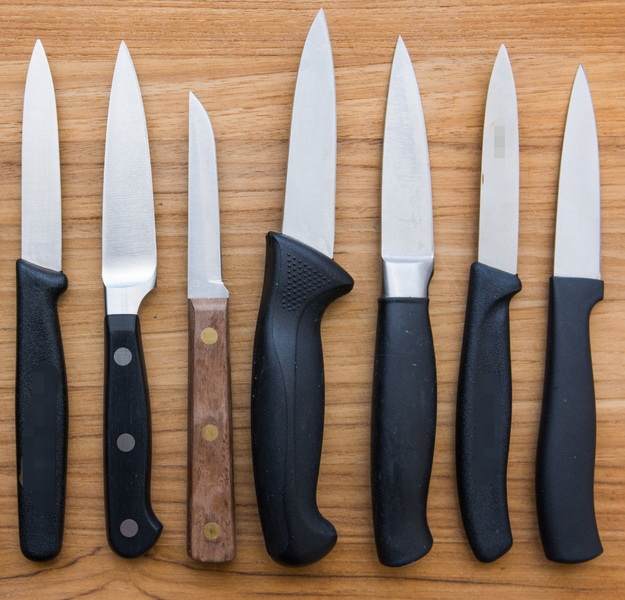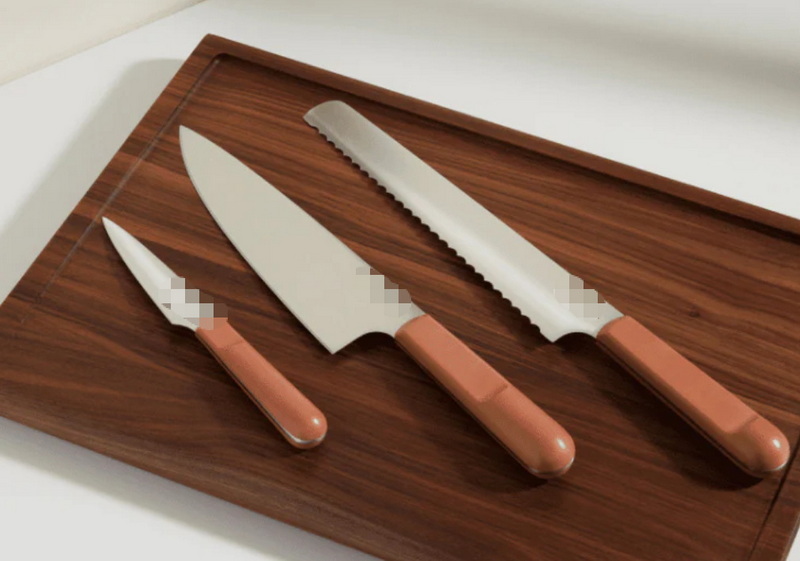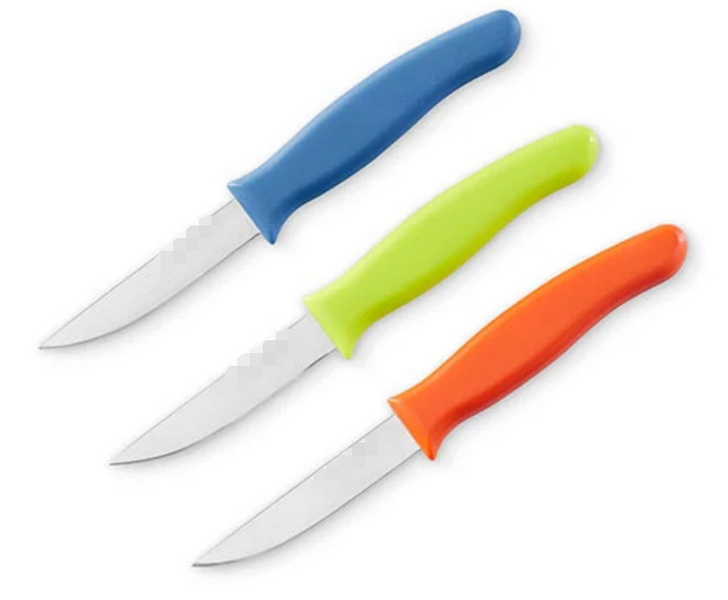- All
- Product Name
- Product Keyword
- Product Model
- Product Summary
- Product Description
- Multi Field Search
Views: 222 Author: Ann Publish Time: 2025-10-24 Origin: Site











Content Menu
● Introduction to Paring Knife Basics
● Why Brands Consider Sets Versus Individually Sold Paring Knives
● Blade materials and geometry
● Handle design and ergonomics
● Manufacturing and quality control
● Safety and compliance considerations
● OEM Delivery and Supply Chain Capabilities
● Market Trends and Regional Demand
● Practical Scenarios: When to Choose Sets, When to Choose Individual Paring Knives
● SEO and Content Optimization
>> What blade materials are most common for Paring Knife sets?
>> Are forged paring knives worth the premium compared to stamped blades?
>> How should Paring Knife care and sharpening be communicated to consumers?
>> What packaging formats work best for Paring Knife sets?
>> Can an OEM partner customize the Paring Knife for different cuisines?
A paring knife is a versatile small blade designed for precise tasks such as peeling, trimming, and delicate cut work. Its compact size makes it ideal for intricate prep, garnishing, and detail work that larger knives cannot perform with the same finesse. From a product development perspective, Paring Knife options can vary in blade material, edge geometry, tang design, handle material, and balance. OEM buyers often seek a reliable supply chain, consistent quality, and the ability to tailor blades to regional cooking styles and safety standards.

- Consumer convenience and perceived value: Sets offer perceived value through bundled functionality and cohesive aesthetics. A well-designed Paring Knife set can create an aspirational kitchen narrative and boost average order value.
- Product assortment flexibility: Individual Paring Knife purchases may appeal to customers who want to customize their toolkit over time or replace a single knife without committing to a whole set.
- Price and margin implications: Sets can optimize packaging, reduce per-unit costs, and improve margin at the point of sale. Individual knives allow price segmentation for budget-conscious buyers and professional users who demand a backup or specialty blade.
- Marketing and brand positioning: Sets support showroom styling, giftable packaging, and cross-sell opportunities with complementary knives (chef's knife, utility knife, boning knife) and knife blocks. Individual knives empower upgrade pathways for enthusiasts and professionals.
- SKU proliferation and supply chain considerations: Sets require coordinated production, packaging, and inventory management, whereas individual knives can simplify stock-keeping units (SKUs) and reduce risk if demand fluctuates.
- Stainless steel vs carbon steel: Stainless steel offers corrosion resistance and low maintenance, while carbon steel provides edge retention and a traditional feel that many chefs value. For OEM projects, material choice can influence production costs, heat treatment, and finishing processes.
- Blade thickness and grind: A thinner blade enhances precision for delicate work but may be more prone to chipping if mishandled. A thicker blade improves durability. OEM partners often provide multiple grind profiles to suit different cuisines and tasks.
- Edge retention and coating: Some OEM models use protective coatings or special polishes to reduce corrosion and improve food release. Coatings can impact cleaning requirements and regulatory compliance.
- Material options: Wood, high-pressure resin, pakkawood, and composite materials are common. Ergonomics focus on grip comfort, weight balance, and slip resistance, especially for prolonged use in professional kitchens.
- Tang and bolster: Full tang construction increases durability and balance, a key selling point for professional users and brands emphasizing longevity.
- Forged vs stamped blades: Forged blades typically offer superior balance and edge retention, while stamped blades can reduce cost and enable high-volume production. OEM buyers should align blade style with target markets and price points.
- Heat treatment and tempering: Consistent hardness ensures predictable performance. OEM partnerships benefit from documented QC processes such as hardness testing, metallography, and finish consistency.
- Surface finish: Polished, satin, or mirror finishes affect aesthetics and maintenance requirements. Surface uniformity is crucial for premium branding and perceived quality.
- Sets vs standalone gifting: Gift-ready packaging for a Paring Knife set often includes a knife block, sleeves, or storage case. Standalone paring knives require elegant yet compact packaging with strong brand storytelling.
- Safety and user guidance: Inserts with care tips, sharpening guidance, and usage illustrations add value and reduce post-purchase support.
- Food contact compliance: Materials and coatings must meet food-grade standards across target markets (e.g., EU, US, Asia). Documentation such as material safety data sheets and compliance certificates may be required.
- Handling and storage: For sets, consider blade guards and secure placement to prevent accidents during shipping and in home kitchens.
- Country-specific standards: Some markets require specific labeling and safety marks. OEM partners should map regulatory requirements early in the product development process.

- Minimum order quantities (MOQs): Many manufacturers set MOQs for forged sets or individual knives. Clear MOQ alignment helps manage client expectations and production planning.
- Lead times and capacity planning: For large sets, production scheduling and packaging logistics can impact delivery timelines. An experienced Chinese kitchen knife factory can offer scalable options, including pre-assembly and kitting services.
- Quality control checkpoints: Pre-shipment inspections, random blade-edge checks, and packaging QA help maintain brand reputation across global customers.
- Customization options: Private labeling, logo laser engraving, and bespoke packaging enable foreign brands to differentiate themselves in crowded markets.
- North America and Europe: Preference for premium sets with esthetically cohesive blocks and high-end handles. Buyers often seek bundles that combine versatility with display-ready packaging.
- Asia and the Middle East: Growing interest in compact sets that maximize countertop space, with emphasis on knife blocks and space-saving storage.
- Emerging markets: Budget-friendly sets or modular options that allow upgrades over time can be attractive to new brand entrants.
- Scenario A: High-end boutique brand seeking a cohesive kitchen knife system. Choose a Paring Knife set alongside matching blades and a premium block to reinforce brand identity and cross-sell opportunities.
- Scenario B: Retailer prioritizing breadth of choice and stock flexibility. Offer individual Paring Knife options with modular packaging to allow customers to build a custom toolkit over time.
- Scenario C: Brand entering a price-sensitive market. Consider a compact Paring Knife set with cost-optimized packaging or a small range of individual Paring Knife SKUs to manage margins.
- Core keyword usage: Paring Knife appears frequently as the central keyword, but ensure natural usage to preserve readability. Use synonyms such as “paring blade,” “paring knife set,” and “small utility knife” where appropriate.
- On-page structure: Use clear H tags (H1 for title, H2 for main sections, H3 for subsections) to create a logical information hierarchy. Include a dedicated FAQ with concise answers.
- Internal and external signals: Link to related OEM capabilities, product care guides, and regional market adaptations to strengthen topical authority.
- Image and video optimization: Provide descriptive alt text and video captions that include the keyword where relevant, and host multimedia on a platform that supports responsive loading for international audiences.
Choosing between a Paring Knife set and individual Paring Knife offerings depends on brand strategy, market requirements, and supply chain capabilities. A well-executed OEM program from a China-based kitchen knife factory can deliver both approaches with consistent quality, enabling foreign brands to capture diverse customer segments while maintaining efficient production and scalable packaging options. The Paring Knife remains a core tool that embodies precision, control, and culinary craftsmanship, whether sold as an integrated set or as individual pieces.

- Answer: Most Paring Knife sets use stainless steel or high-carbon stainless steel blades, chosen for a balance of corrosion resistance, edge retention, and ease of maintenance. OEM partners often offer multiple steel grades to fit different price points and regional cooking styles.
- Answer: Forged paring knives typically provide better balance, edge geometry, and durability, which many professionals value for precise tasks. Stamped blades can be more cost-effective for mass-market assortments, enabling broader SKU coverage.
- Answer: Provide concise care guidance: hand wash, dry promptly, and store safely. For sharpening, recommend a proper technique (whetstone or guided sharpening system) with periodic maintenance intervals based on usage. Include safety reminders to prevent accidents.
- Answer: Gift-ready packaging with a cohesive color story, protective blade guards, and an attractive knife block or magnetic organizer tends to perform well. For standalone paring knives, sleek, compact packaging with clear branding and care instructions is effective.
- Answer: Yes. OEM factories can tailor blade shape, grind, handle material, and packaging to align with regional culinary practices and brand positioning, enabling tailored marketing and performance benefits.
The Ultimate Professional Knives for Halal Butchery in Middle Eastern Kitchens
Chef Knife Size Guide: Choosing Between 6″, 8″, 10″, And 12″
Custom Knife Handles: How To Design A Chef Knife That Fits Your Hand Perfectly
Chef Knife Surface Treatments Guide: From Polished Migaki To Damascus Patterns
Inside Our Professional Knife Sample Room: Quality You Can See
Universal Knife Block Buying Guide: Modern Acrylic & ABS Knife Holders for Professional Kitchens
Universal Knife Block: The Complete Guide To Modern, Hygienic Knife Storage
The Complete Guide To Red Handle Knife Sets: Style Meets Functionality in The Kitchen
Professional Knives for Halal Butchery And Middle Eastern Cuisine